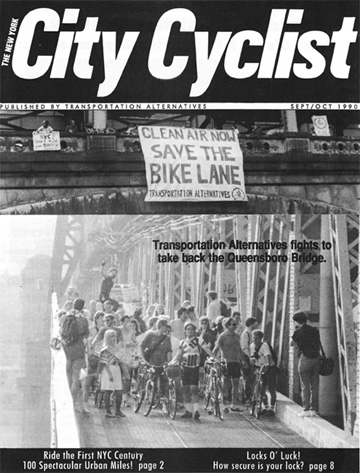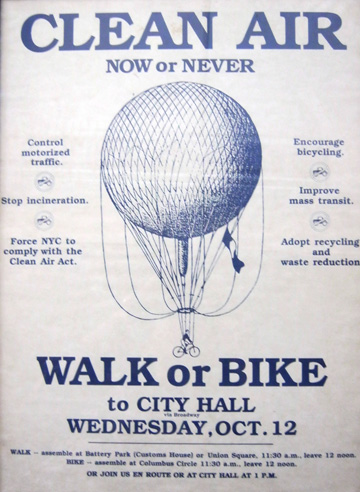The Bicycle Uprising, Part 4
12:13 PM EDT on August 28, 2012
This is the fourth installment in a multi-part series looking back at the victory over the Midtown bike ban, 25 years ago. Read parts one, two, and three for an overview of the bike ban, the advocacy of the 1970s and 80s, and the aftermath of the ban. Activists are planning a September 28 bike ride and forum to commemorate and celebrate the events of 1987, and Streetsblog readers are invited to participate and contribute.
The heightened political consciousness and enthusiasm for direct action that suffused the New York cycling community during the victorious campaign against the Midtown bike ban remained for years and led to enduring accomplishments:
“River Road” (1988-89) -- Cyclists’ next “access victory” overturned a rule banning cycling on all but weekend mornings on Henry Hudson Drive, a spectacular eight-mile ribbon of road sculpted out of the New Jersey Palisades and administered by the Palisades Interstate Park Commission. This campaign started with a pro forma request from Transportation Alternatives to the Commission’s director to rescind the ban. But what got it rolling was an April 1988 TA ride in which park police arrested one cyclist and detained a dozen others who had dutifully attempted to exit by walking up mile-long Alpine Hill. Photos of the arrests snapped by a couple who had been politicized by the midtown protests were published in City Cyclist and made the campaign a cause célèbre for all cycling groups.
The park commissioners seemed sympathetic, and needed ammunition to override their director’s adamant objections. The cycling community eagerly complied, with American Youth Hostel’s Bike NY coordinator authoritatively detailing how New York-area cyclists could safely share the narrow road with cars, and a New York Cycle Club legal specialist dismantling the director’s overblown liability concerns. But just getting to that crucial vote took months of letter-writing and back-channel communications, including persistent lobbying that produced a Times editorial suggesting a trial period for shared use. During the month-long trial, in July 1989, cyclist volunteers distributed “rules of the road” flyers and marshaled the road, winning over the park director who then made the experiment permanent.
George Washington Bridge (1989-1990) -- An archaic rule restricting bicycling to the GWB’s north path and requiring cyclists to trudge up and down five staircases totaling 170 steps began to be enforced around the time of the Midtown bike ban, resulting in flurries of summonses for cycling on the ramped south path. Following the win on River Road, TA embarked on a campaign of quiet diplomacy with the Port Authority to gain legal access to the south path. We crunched bridge usage data and showed that wheelchair use of the south path wasn’t nearly frequent enough to support a blanket prohibition against cycling. We won over a vocal opponent, a competitive runner from Washington Heights, by persuading him that legalizing cycling on the south path would deter aggro riding (here we drew on the downward trend of NYC bike-pedestrian crashes after beating back the Midtown bike ban) and would curb muggings on the bridge by adding “eyes on the path.” And we mobilized TA members to write not just Port Authority staff but also the chair of the State Assembly committee who oversaw their operations.
The coup de grace was actually delivered by the Palisades Park Commission director. At our urging, he wrote to Port Authority staff to attest that opening River Road to cycling had been the right move all along. (A key step in winning his goodwill had been our accepting his conditions for River Road access, including a helmet requirement and a continued ban on using the serpentine Englewood Cliffs approach road.) The Port lifted the ban on cycling on the GWB’s south path in 1990.
Clean Air Now or Never! (1988) -- New York’s air was much more polluted in the late eighties than today, and the number one reason, particularly at street level, was car exhaust. That non-polluting bikes could fulfill the same personal travel functions as pollution-spewing cars was a compelling argument for urban cycling, particularly after the summer of 1988, the hottest then on record, when New York baked in 100-degree heat, much of Yellowstone burned, and NASA climatologist James Hansen publicly pointed the finger of science at climate change from burning fossil fuels.
To dramatize the twin air and climate crises, TA staged a march and rally at City Hall. Like most of our protests, the action received little attention in the media -- the eighties were pre-blogs and pre-Internet, of course, and we relied for communications and publicity on flyers, word of mouth, and City Cyclist, all volunteer-driven. Nevertheless, our October 1988 rally, with speeches from local and national activists and scientists, helped start the process of awakening the established environmental organizations to cycling. It also became a template for our 1989 Earth Day ride to the Exxon building on Sixth Avenue, where Greenpeace demonstrators hailed us as heroes (this was a month after the Exxon Valdez dumped its crude into Alaska’s Prince William Sound), and our February 1991 No Blood for Oil ride during the first Gulf War. While these actions didn’t stop drilling or killing for oil, they helped enshrine TA as the city’s pre-eminent grassroots green group. They also kept TA’s volunteer base energized, which helped maintain vital but mundane work like midtown bike-traffic counts and newsletter distribution.
The Queensboro Bridge Bike Lane (1990-91) -- Notwithstanding the actions and victories emanating from the 1987 bike ban uprising, cycling conditions in the city were barely improving as the 1980s gave way to the 1990s. If anything, rampant traffic gridlock and the new plague of massive, overpowered SUV's were making bike riding more perilous. Hopes that Mayor-elect David Dinkins would honor his 1989 campaign promises to expand the city's cycling infrastructure were dashed the following spring, when the DOT told cyclists the Queensboro Bridge South Outer Roadway bike path would be turned over to cars on weekday afternoons and evenings. The DOT van-shuttle alternative was cumbersome and unreliable, and stranded Queens bike commuters looked to TA.
The response was a series of Monday evening actions in which cyclists and pedestrians marched onto the South Outer Roadway and physically prevented cars from entering the lane. One leader of these demonstrations, John Kaehny, a young transplant from Denver living in Astoria, had a gift for articulating a vision of New York City as a place where bicycling could find political voice and be woven into the city’s fabric. As word of Kaehny's oratory spread, the weekly actions became a happening, with the crowd swelling to 50 or 60 by summer. On one Monday evening, New Yorkers journeying up First Avenue gazed up at banners we had painted at TA director Jon Orcutt's Lower East Side loft and hung from the bridge railing: CLEAN AIR NOW and JUST ONE LANE.
The bust came on the last Monday in October 1990. The police permitted the group to turn back, but a half-dozen demonstrators, including Kaehny, Orcutt, and Ann Sullivan, who would soon succeed me as TA board president, chose arrest. At our trial for disorderly conduct that winter, the former DOT Commissioner Ross Sandler conceded under cross-examination that 40 years of adding auto lanes to Manhattan, whether by building new roads or appropriating sidewalks and bicycle paths, had only compounded gridlock and pollution. When the judge announced her verdict for the “QB 6” in March 1991, it was a stunner: She said our actions had served the public interest by safeguarding cyclists and pedestrians who might have ventured onto the bike path. It was the first “necessity” acquittal in New York State history. The New York Law Journal featured the case, and Newsday covered our victory in a feature story that cast bicycling advocates as valiant but quixotic.
Thanks to this advocacy and further demonstrations, the Queensboro Bridge was re-opened to bikes the following year, with access alternating between the South and North Outer Roadways. Not long after, the decrepit bike and pedestrian path on the Williamsburg Bridge was restored, following a TA-led campaign that included demonstrations with Brooklyn Hasidim, and the long-closed path on the Manhattan Bridge was reinstated, with both bridges getting new lighting and ramps to replace stairs. The planning and investment that accomplished these steps didn’t happen overnight, of course, but they were accelerated by relentless pressure from TA.
Next week: Auto-free NY, traffic pricing, and the epilogue.
Charles Komanoff is a national expert on congestion pricing and traffic modeling, and is the former head of Transportation Alternatives. He is a longtime Streetsblog contributor. Reach him at komanoff@gmail.com.
Stay in touch
Sign up for our free newsletter
More from Streetsblog New York City
What to Say When Someone Claims ‘No One Bikes or Walks in Bad Weather’
Yes, sustainable modes are more vulnerable to bad weather. But that's why we should invest more in them — not less.
NYC Transit’s New Operations Chief Wants To Fight ‘Ghost Buses’
One-time transit advocate and current MTA Paratransit VP Chris Pangilinan will oversee bus and subway operations for the whole city.
Friday’s Headlines: Gimme Bus Shelter Edition
The days of the Landmarks Preservation Commission reviewing every proposed bus shelter in landmarked districts may be no more. Plus more news.
Deal Reached: Hochul Says ‘Sammy’s Law’ Will Pass
The bill, though imperfect, has been four years in the making.
Komanoff: A ‘Noise Tax’ Can Ground NYC Helicopters
A proposed $400 “noise tax” on “nonessential” flights is a start — and it will work.






